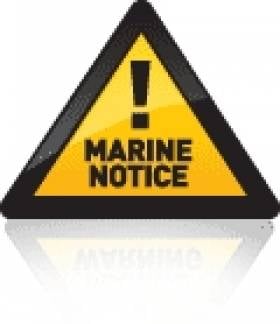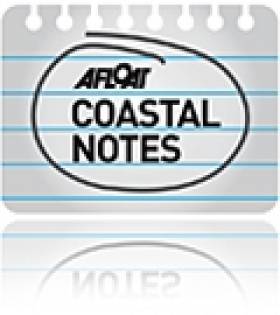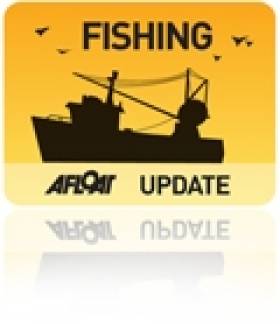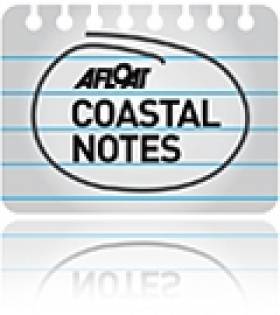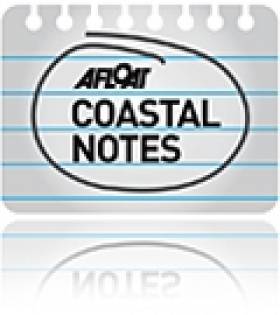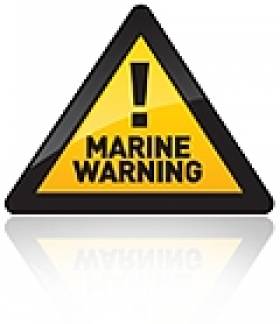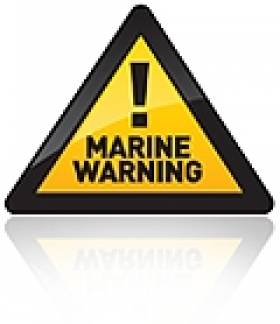Displaying items by tag: Celtic sea
Marine Notice: Geophysical Survey In Celtic Sea
#MarineNotice - The latest Marine Notice from the Department of Transport, Tourism and Sport (DTTAS) advises that Osiris Projects were last week scheduled to begin marine survey operations off the south coast in the Celtic Sea.
The marine surveys will extend from the shoreline at two locations in Co Cork across the sea to the shoreline at two locations in northern France.
The survey was set to start on Monday 1 June 2015 to last for approximately three weeks, weather permitting. The survey will be conducted by the MV Proteus (Callsign 2HBL7).
The marine surveys will extend from the shoreline at Ballinwilling Strand (main route) and Ballycroneen Beach (alternative route), across the Celtic Sea, passing the Isles of Scilly, to the French coast west of Roscoff at Moguériec (main route) and Pontusval (alternative route).
The corridor width for each landing will be 250 metres from the high water mark to the 10-metre contour, then the corridor will widen to 500m as the route moves to France.
The survey vessel may be found running both along the corridor, and in the general vicinity of the survey corridor. The survey areas are small boxes which are shown in the detail plan HERE.
Survey operations will involve towing survey equipment on and below the water surface, up to 300m behind the vessel. All vessels, particularly those engaged in fishing, are requested to give the MV Proteus and her towed equipment a wide berth and keep a sharp lookout in the relevant areas.
Full co-ordinates for the relevant work areas are detailed in Marine Notice No 25 of 2015, a PDF of which is available to read or download HERE.
Petronas Subsidiary Takes Majority Stake In East Kinsale Gas Prospect
#Oil&Gas - Kinsale Energy will take an 80% stake in Landsdowne Oil and Gas's Midleton/East Kinsale gas prospect in the Celtic Sea, as The Irish Times reports.
The deal will see the Petronas subsidiary assume 100% of costs for drilling on the prospect and will fund Lansdowne's costs of testing for up to $2.5 million.
Kinsale Energy, which was formerly Marathon Oil, already holds an interest in the Deep Kinsale Prospect beneath the Kinsale Head Gas Field, thanks to its option agreement with Fastnet Oil & Gas last year.
The Irish Times has more on the story HERE.
#Fishing - Marine Minister Simon Coveney yesterday (10 November) held a bilateral meeting with the new French Fisheries Minister Alain Vidalies in Brussels.
The meeting was organised to prepare for negotiations on the 2015 fish quotas which will be decided at the Fisheries Council on 15 and 16 December.
This was the first meeting between Minister Coveney and Minister Vidalies.
“France and Ireland have important shared fisheries in the Celtic Sea," said Minister Coveney. "I met Minister Vidalies to discuss with him the issues of importance relating to the management of these fisheries.
"I pointed out that the Irish and French fishing industries have a strong working relationship and that I wanted to ensure that this relationship is fully reflected at political level.”
The minister added: “There are particular issues arising in the Celtic Sea and our industries have worked together to bring forward measures to increase selectivity and reduce discarding of young fish. The EU Commission has proposed very severe quota cuts to the key cod and haddock fisheries.
"I agreed with Minister Vidalies that we will work closely over the coming weeks to secure agreement to a package of measures involving improved selectivity measures and set quota levels that take into account the most up to date scientific advice.“
The EU Commission has published its proposals for Total Allowable Catches and quotas for 2015. The commission has proposed a 64% quota cut for Celtic Sea cod for 2015 and a 41% cut for haddock in the Celtic Sea. The EU Commission has yet to make its proposal for the Celtic Sea whiting and prawn quotas for 2015.
Submissions from all stakeholders have been sought by 21 November to inform a Sustainability Impact Assessment which will be presented to the Oireachtas by Minister Coveney on 2 December.
Marine Notices: Survey Operations In The Celtic Sea, Off Southwest Coast
#MarineNotice - The latest Marine Notice from the Department of Transport, Tourism and Sport advises that Osiris Projects will be carrying out two survey operations along the proposed interconnector route between Ireland and France.
The surveys will extend from the Shoreline at two locations in Co Cork (Ballinwilling Strand main route and Ballycroneen Beach alternative route) across the Celtic Sea to the shoreline at two locations in Northern France (Roscoff main route and Pontusval alternative route).
The first survey operation started on 17 August and is expected to run until 30 September, weather permitting. Survey works will be undertaken on the survey vessel RRS Ernest Shackleton (Callsign ZDLSI).
The vessel will operate on a 24-hour basis, will display appropriate day shapes and lights during survey operations and will actively transmit an AIS signal.
The RRS Ernest Shackleton will be towing survey equipment below the surface up to 600m behind the vessel. A wide berth is requested at all times as the vessel will be restricted in her ability to manoeuvre.
The second survey operation was expected to start on the Irish side yesterday (10 September) and will run until 20 September, weather permitting. Survey works will be undertaken on the survey vessel MV Proteus (Callsign 2HBL7).
The vessel will operate on a 12-hour basis, will display appropriate day shapes and lights during survey operations and will actively transmit an AIS signal.
The corridor width for each landing will be 250 metres from the high water mark to the 10-metre contour, then the corridor will widen to 500 metres as the route moves to France.
The survey vessel may be found running both along the corridor and in the general vicinity of the survey corridor. The vessel will be working between high water and 20 metre contour and in daylight hours only.
The MV Proteus will be towing survey equipment on and below the water surface up to 300m behind the vessel. A wide berth is requested at all times as the vessel will be restricted in her ability to manoeuvre.
Both vessels will be listening on VHF Channel 16 throughout the works. Full details of co-ordinates of the work areas are included in Marine Notice No 55 of 2014, a PDF of which is available to read or download HERE.
Meanwhile, a hydrographic and geophysical survey operation is presently being undertaken by INFOMAR on the RV Celtic Voyager off the southwest coast of Ireland, continuing till 17 September.
The vessel is towing a magnetometer sensor with a single cable of up to 100m in length. A wide berth is requested at all times as the vessel will be restricted in her ability to manoeuvre.
The vessel will display appropriate lights and markers, and will be listening on VHF Channel 16 throughout the project.
Co-ordinates for the bounding box of the survey area are detailed in Marine Notice No 54 of 2014, a PDF of which is available to read or download HERE.
Providence Dismisses Setback Claims Over Barryroe Prospect
#Oil - News that the Barryroe prospect off the south coast requires a new appraisal well at a cost of some €30 million sent shares in Providence Resources tumbling on the Dublin market as trading opened today.
But the Irish oil and gas firm says there has been no setback to its plans for the oil field and "no material change" to its status, as The Irish Times reports.
And the company says it remains in discussions with "major Asian, European and North American oil companies" to tap Barryroe as a collaborative venture that's expected to be worth billions to the Irish economy.
Shares fell 9% this morning following a Sunday Times article that suggested Providence would seek funds from shareholders for new drilling in the Celtic Sea prospect.
#MarineNotice - The latest Marine Notice from the Department of Transport, Tourism and Sport (DTTAS) advises of a previously uncharted rock outside the approaches to Dingle's Fishery Harbour Centre.
The rocky outcrop or shoal was identified by the Geological Survey of Ireland (GSI) vessel RV Geo recently, and appears to be part of the shoreward extension of the Crow and Colleen-oge Rocks.
Full details of its depth and position are included in Marine Notice No 37 of 2013, a PDF of which is available to read or download HERE.
In other news, the Marine Institute is conducting a pipeline and platform superstructure (or 'jacket') survey in the Celtic Sea.
The survey, on behalf of Kinsale Energy Limited, was scheduled to commence last Monday 22 July and will continue till Friday 30 August.
Works are being conducted by the MV Granuaile (Call sign EIPT) which is carrying out underwater operations using a remote operated vehicle (ROV) making 0.4 to 0.7 knots over the ground. The vessel is listening on VHF Channel 16 throughout the project.
All vessels, particularly those engaged in fishing, are requested to give the MC Granuaile a wide berth and keep a sharp lookout in the relevant areas. Full details of co-ordinates are included in Marine Notice No 36 of 2013.
Dinghy Man Rescued Attempting Daft UK-Ireland Crossing
#CelticSea - A British man's unorthodox attempt to cross the Celtic Sea from Dorset to Ireland has come to an end after he was rescued by the UK coastguard.
A RTÉ News reports, the man was discovered some 2.7 nautical miles south of Durdle Door on Dorset's Jurassic Coast in a 6ft inflatable dinghy.
He was found with two paddles - one being used with a plastic sheet as an improvised sail - plus a limited amount of food and drink, and no suitable communication or lifesaving gear.
Rescuers later brought the man back to shore where he was treated for severe sunburn.
RTÉ News has more on the story HERE.
#DeepKinsale - Fastnet Oil & Gas believes that its Deep Kinsale Prospect in the Celtic Sea could hold an incredible bounty of more than two billion barrels of oil.
As Proactive Investors reports, the Irish-headed oil exploration firm says an independent assessment of its prospect in the waters south of Cork estimates 2.365 billion barrels of oil in place.
Fastnet executed its exclusive option on the prospect earlier this year, and recently completed a 3D seismic survey of the area, the data from which will enable the company to identify oil reservoir 'sweet spots' for the best drilling results.
“Deep Kinsale is a large anticlinal structure, which has the potential to contain a significant oil accumulation directly beneath the producing Kinsale gas field and the two platforms, in the Celtic Sea,” said John Craven, founding Fastnet shareholder.
“This new 3D seismic is a key de-risking component necessary for the planning of an optimal drilling campaign."
The full operational update from Fastnet Oil & Gas is available HERE.
As previously reported on Afloat.ie, Fastnet Oil & Gas has been awarded a new licensing option elsewhere in the Celtic Sea in the area know as East Mizzen.
#MarineNotice - The busy waters of the Celtic Sea will next month see yet another seismic survey.
Marine Notice No 23 of 2013 advises that Seabird Exploration, on behalf of Spectrum Geo Limited, is scheduled to carry out a 2D seismic survey over the Celtic Basin from the beginning of June till the end of July.
The seismic acquisition will be carried out by the vessel M/V Harrier Explorer (Call sign 3EIE3), which will be accompanied at all times by guard vessel M/V Nomad (Call sign EI5298).
The proposed survey consists of 3,570km of a 2D seismic survey over the Celtic Basin. The survey vessel will travel at 4-5 knots, towing a single solid 8km streamer located some 9 metres below the surface, with a turning diameter of approximately 5km required.
Both vessels will be listening on VHF Channel 16 throughout the project. All vessels, especially those engaged in fishing, are requested to give them a wide berth and keep a sharp lookout in the relevant areas - the co-ordinates of which are outlined in the PDF available to read or download HERE.
Marine Notice: 3D Seismic Survey in Celtic Sea Update
#MarineNotice - CGG, on behalf of Fastnet Oil & Gas, is scheduled to carry out a full 3D seismic survey at Mizzen Basin in the Celtic Sea off the south-west coast beginning this month.
Details of this survey - as part of Fastnet's option on the Deep Kinsale Prospect - were previously reported on Afloat.ie but some details have been amended since.
The survey is expected to run for 35 days, subject to weather.
For full details - including co-ordinates of the work areas - see Marine Notice No 22 of 2013, a PDF of which is available to read or download HERE.


























